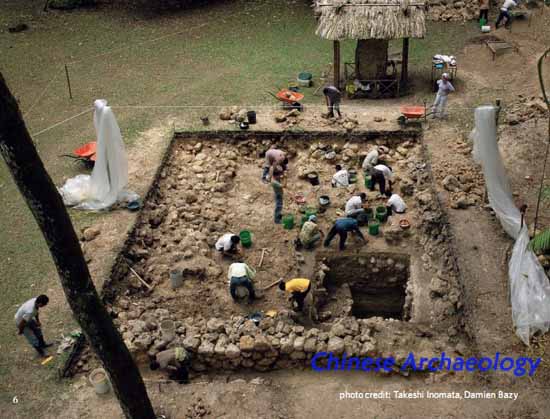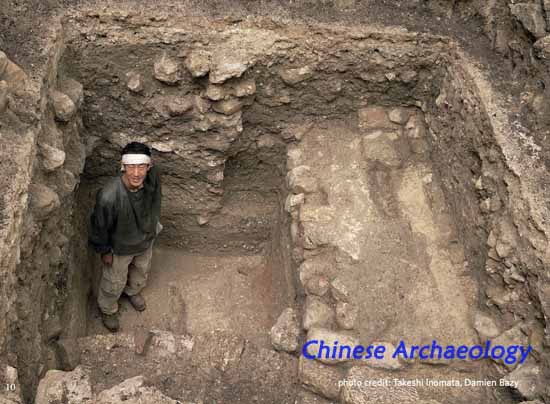Early Ceremonial Constructions at Ceibal, Guatemala, and the Origins of Lowland Maya Civilization
During the Early Middle Preclassic period (1000 to 700 BCE), sedentary communities and the earliest ceramics began to appear in the Maya lowlands. In other areas within Mesoamerica, many societies had settled into sedentary communities and began producing ceramics during the Early Preclassic period (approximately 2000-1000 BCE). The Gulf Coast Olmec of southern Veracruz and western Tabasco constructed a large center at San Lorenzo and were producing elaborate stone sculptures during the Early Preclassic. Scholars have long debated the influence that the Gulf Coast Olmec had on the development of lowland Maya society. Some argue that the Gulf Coast Olmec constituted a “mother culture”: the source of cultural innovations, including iconography and centralized political organization that spread to the Maya and other Mesoamerican groups. Others contend that the lowland Maya received only limited Olmec influence or interacted with the Olmec as competing peers. Central to understanding this relationship is the development of formal architectural complexes consisting of plazas and pyramids, which eventually became the hallmarks of Mesoamerican civilizations. The spread of plaza-pyramid complexes across southern Mesoamerica during the Early Middle Preclassic period provides critical information regarding the origins of lowland Maya civilization and the role of the Gulf Coast Olmec in this development.

Excavations at Ceibal, Guatemala, conducted by Harvard University in the 1960s, revealed that the center was first occupied in the Early Middle Preclassic period. Building on Harvard’s investigations, in 2006 the Ceibal-Petexbatun Archaeological Project, directed by Takeshi Inomata, began carrying out more extensive excavations in Ceibal’s ceremonial center to expose the earliest occupation of the site. One of our primary concerns has been to refine Ceibal’s chronology through more precise stratigraphic control and extensive radiocarbon dating. In light of the newly-refined chronology, our research has revealed that an early “E-Group” architectural complex was first built around 1000 BCE. E-groups consist of a western pyramid and a long eastern platform and are characteristic of Middle Formative centers in the state of Chiapas, Mexico. The E-group at Ceibal predates all other known examples found in Chiapas, at lowland Maya centers, and at the Olmec center of La Venta. That is not to say that Ceibal’s E-group was the first ever built, or that it was a purely Maya invention. The founders of Ceibal were undoubtedly in contact with settlements in nearby Chiapas, and foundational caches of greenstone axes in the Ceibal E-group show a connection to the Gulf Coast Olmec.

In addition to refining the chronology of the Early Middle Preclassic constructions at Ceibal, it is important to consider the social roles that these buildings and spaces played in specific historical contexts. The data from Ceibal make it clear that the original ceremonial complex was built as a stage for communal ritual performances. Instead of gradually transitioning from a small village to a ceremonial center, the residents of Ceibal built a formal public space as soon as they adopted a sedentary way of life. Numerous offerings, including greenstone axes, were deposited in the E-group plaza throughout the Middle Preclassic period, indicating that this space remained the primary stage for communal ritual.

New data from Ceibal suggest that the development of lowland Maya civilization did not result from unidirectional influence from the Olmec center of La Venta, but rather from interregional interactions involving groups in the southwestern Maya lowlands, Chiapas, the Pacific Coast, and the southern Gulf Coast. Ceibal was not a passive recipient of an idea established elsewhere, but rather participated actively in a process of innovation. During the Late Middle Preclassic period (700-400 BC), Ceibal maintained its original formal plaza, but in terms of construction methods and ceramics, the site was more closely affiliated with the rest of the Maya lowlands than with Chiapas and the Gulf Coast.
Takeshi Inomata & Damien Bazy (University of Arizona)
Biographical sketch
Takeshi Inomata earned his Ph.D. in Anthropology from Vanderbilt University in 1995. He has worked in the La Entrada region in Honduras and Aguateca and Ceibal in Guatemala. His publications include The Classic Maya (with Stephen Houston, 2009, Cambridge University Press), Archaeology of Performance: Theaters of Power, Community, and Politics (with Lawrence Coben, 2006, AltaMira Press), and Early Ceremonial Constructions at Ceibal, Guatemala, and the Origins of Lowland Maya Civilization (Science 340:6131).
Damien Bazy graduated from the University of Paris 1 where he defended his dissertation titled The Relation between Public and Private Places in the Central and Southern Lowlands Maya Cities from the Preclassic to the Terminal Classic. His investigations focus primarily on analyzing public and private places, considering them inscribed in a set of spatial relationships, and examining the material, immaterial and ideal forms established by a given society at a given time to express given relationships between distinct social groups. His research is firmly positioned in what might be considered as sociology of Classic Maya societies in Mesoamerica. As a member of the Ceibal-Petexbatun Archaeological Project since 2012, he is currently a visiting scholar at the School of Anthropology, University of Arizona, Tucson, AZ.

